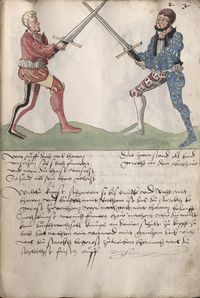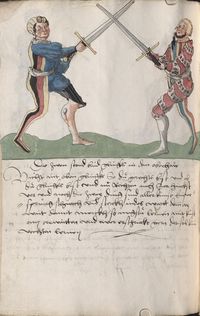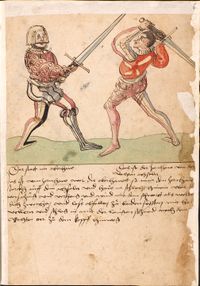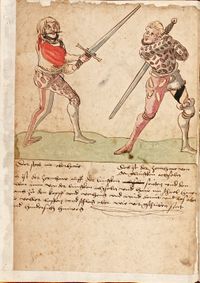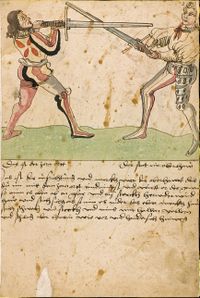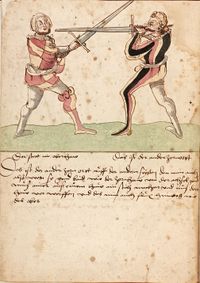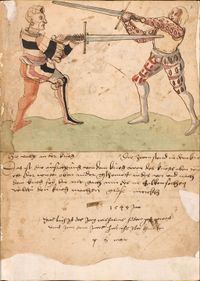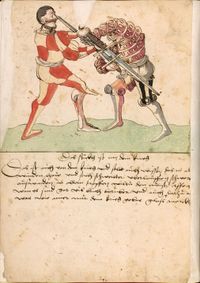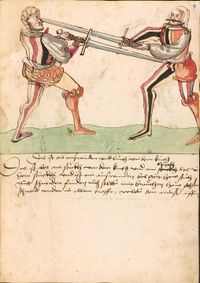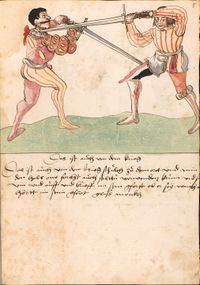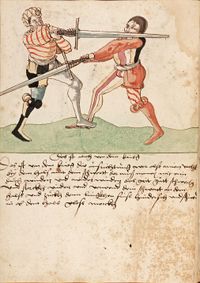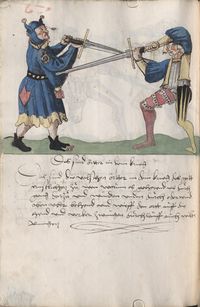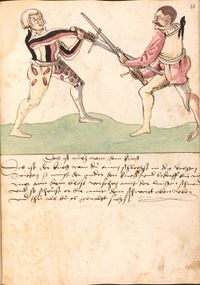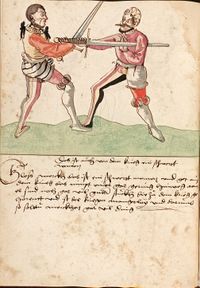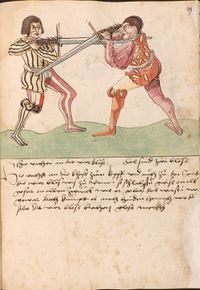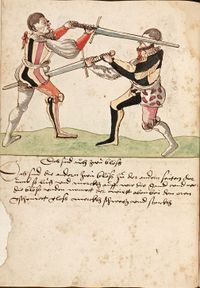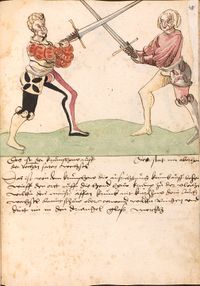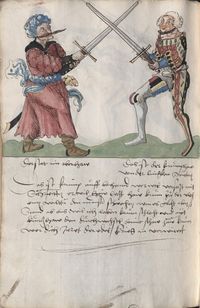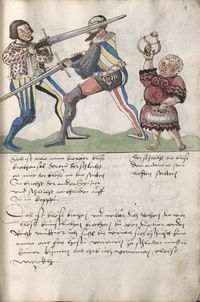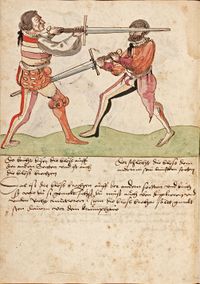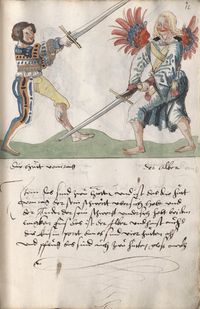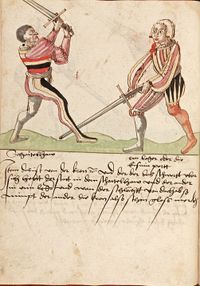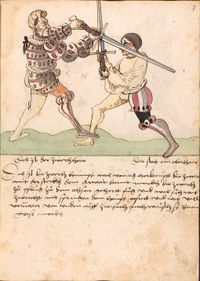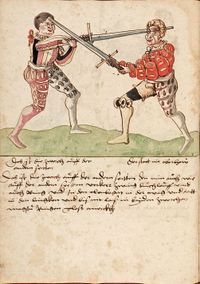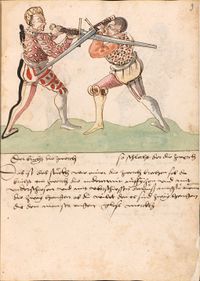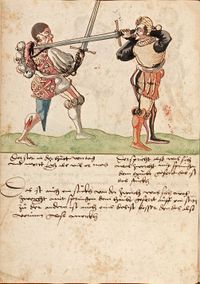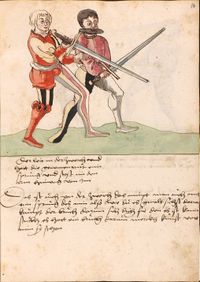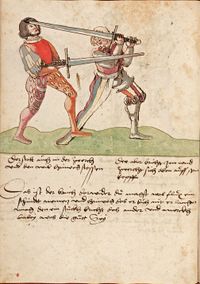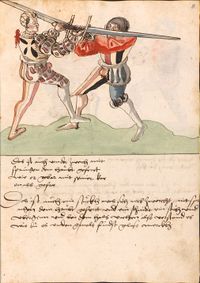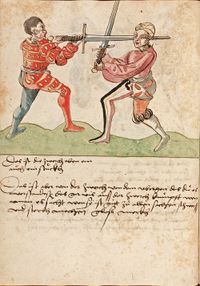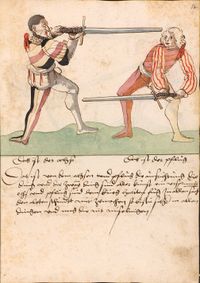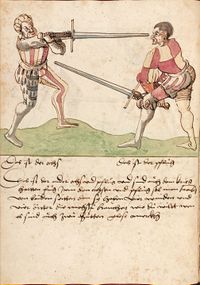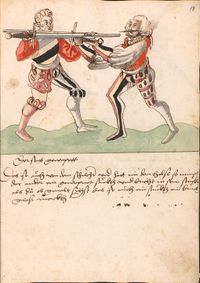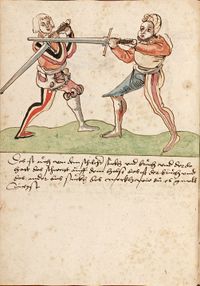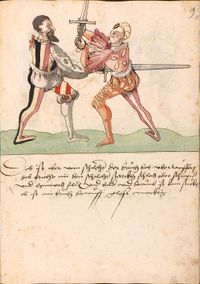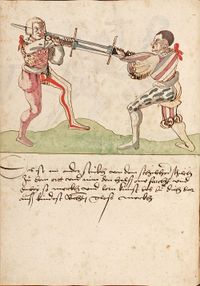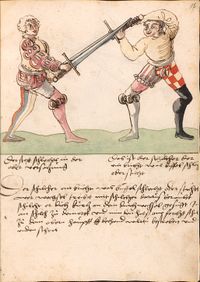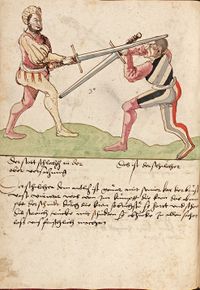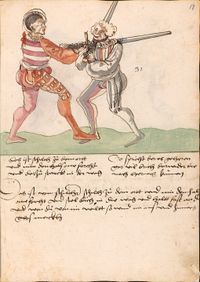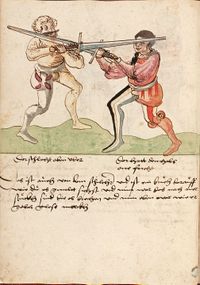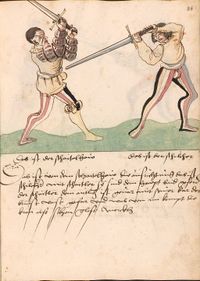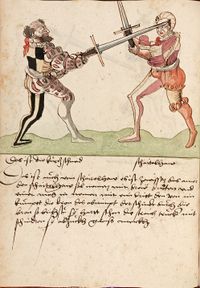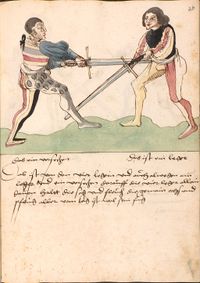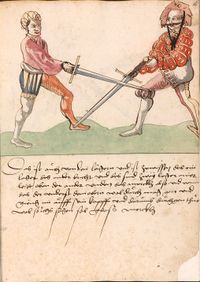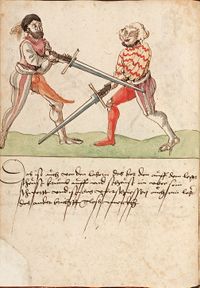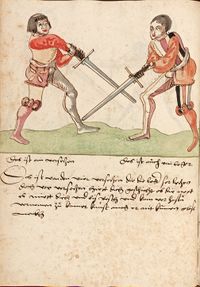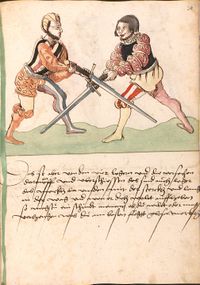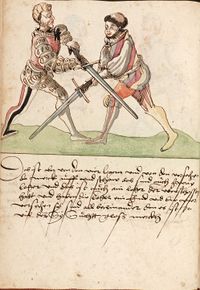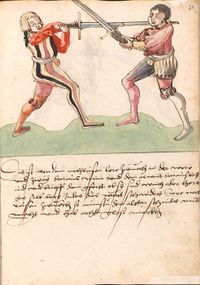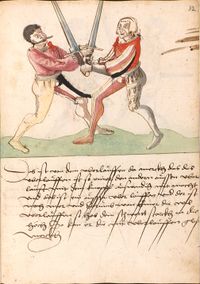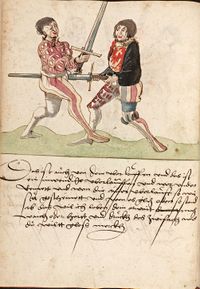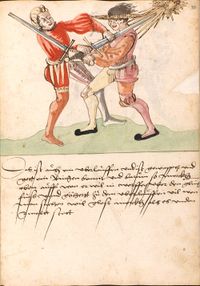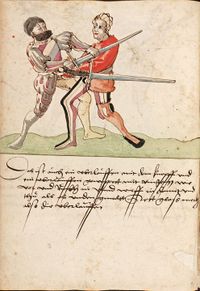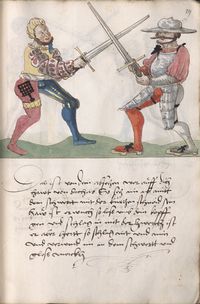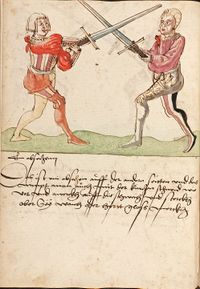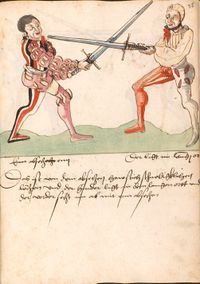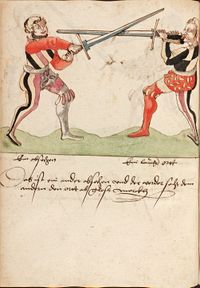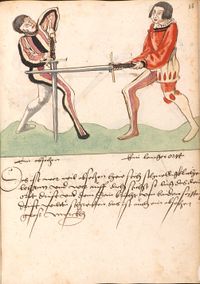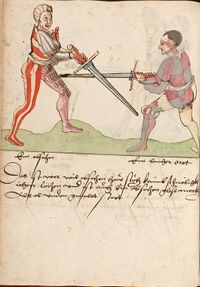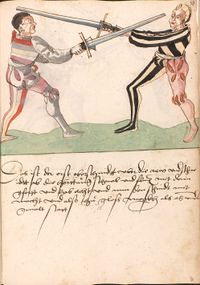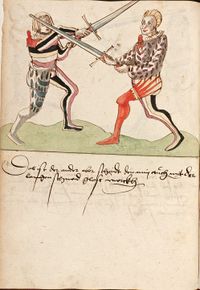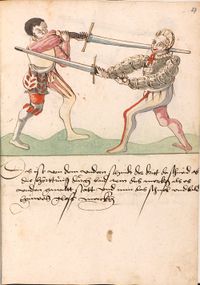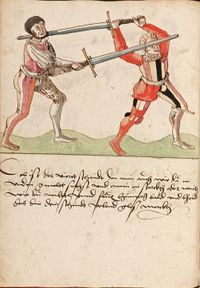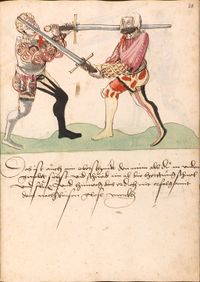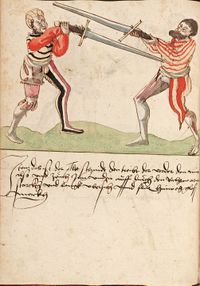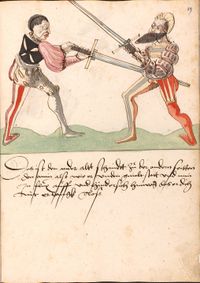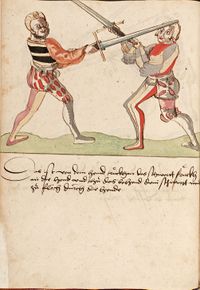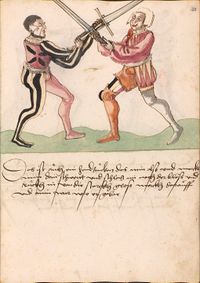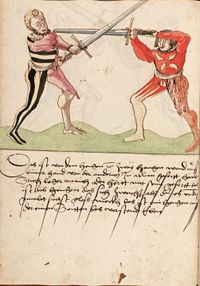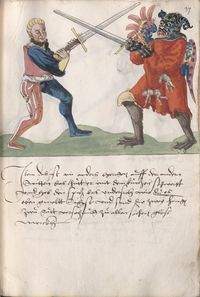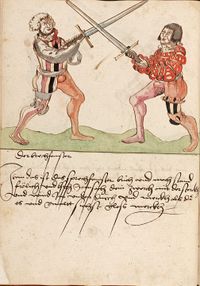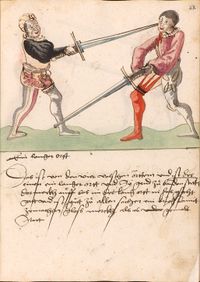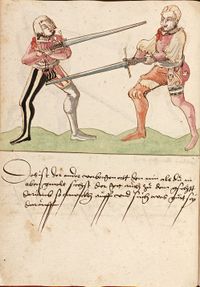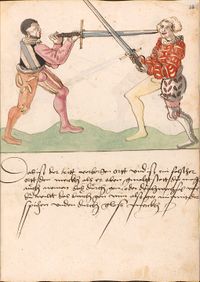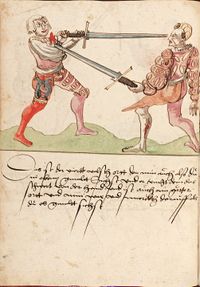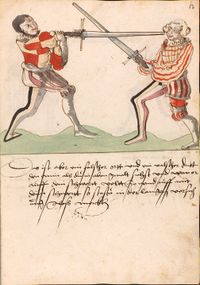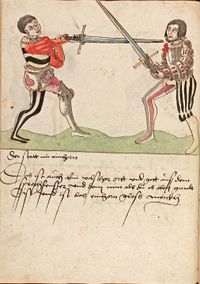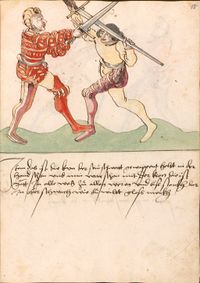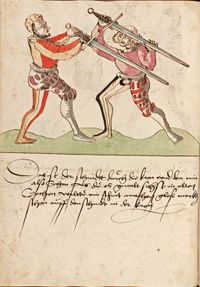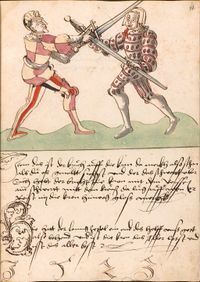|
|
You are not currently logged in. Are you accessing the unsecure (http) portal? Click here to switch to the secure portal. |
Difference between revisions of "Jörg Wilhalm"
| Line 591: | Line 591: | ||
|- | |- | ||
| [[File:Cod.I.6.2º.2 11v.jpg|200px|center]] | | [[File:Cod.I.6.2º.2 11v.jpg|200px|center]] | ||
| − | | | + | | '''[16v]''' This is the thwart in above, also a play. |
| + | This is yet again from the thwart from the above, that you then understand it: That very many come from the thwart, if one seeks it, when it is good makes to all things weak and strong. Gloss note. | ||
| | | | ||
| '''[11v]''' Das ist die zwerch oben ein auch ein stuckh | | '''[11v]''' Das ist die zwerch oben ein auch ein stuckh | ||
| Line 603: | Line 604: | ||
|- | |- | ||
| [[File:Cod.I.6.2º.2 12r.jpg|200px|center]] | | [[File:Cod.I.6.2º.2 12r.jpg|200px|center]] | ||
| − | | | + | | '''[17r]''' This is the ox. |
| + | :This is the plow. | ||
| + | |||
| + | This is the justification for the ox and the plow, the thing and the second thing are an origin of all art. Ox and pflug are justifiably hard in the war, in all things, with which to make the old slice. Thus you are sure in all things and it may not fail you. | ||
| | | | ||
| '''[12r]''' Das ist der ochss | | '''[12r]''' Das ist der ochss | ||
| Line 619: | Line 623: | ||
|- | |- | ||
| [[File:Cod.I.6.2º.2 12v.jpg|200px|center]] | | [[File:Cod.I.6.2º.2 12v.jpg|200px|center]] | ||
| − | | | + | | '''[17v]''' This is the ox. |
| + | :This is the plow. | ||
| + | |||
| + | This is the other ox and plow and are also justifiably hard in the war. Note: The oxen and plow one should drive from both sides, then they have four windings and four points, that you may use as you wish, when they are also two guards. Gloss note. | ||
| | | | ||
| '''[12v]''' Das ist der ochs | | '''[12v]''' Das ist der ochs | ||
| Line 635: | Line 642: | ||
|- | |- | ||
| [[File:Cod.I.6.2º.2 18r.jpg|200px|center]] | | [[File:Cod.I.6.2º.2 18r.jpg|200px|center]] | ||
| − | | | + | | '''[18r]''' He stands armed [in half sword]. |
| + | This is also from the squinter and has thus taken him in the neck. The other, an armed [half sword] play and breaks his play, as you see it pictured. This is also a play, a break. Gloss note. | ||
| | | | ||
| '''[18r]''' Der statt gewappet | | '''[18r]''' Der statt gewappet | ||
| Line 647: | Line 655: | ||
|- | |- | ||
| [[File:Cod.I.6.2º.2 18v.jpg|200px|center]] | | [[File:Cod.I.6.2º.2 18v.jpg|200px|center]] | ||
| − | | | + | | '''[18v]''' This is also from the squinter play and break, and there he has the sword on the neck. This is the break and the other the play. Note that as you see it pictured. |
| | | | ||
| '''[18v]''' Das ist auch von dem schilchr~ stuckh vnd bruch vnd der do hatt das schwertt auff dem halss das ist der bruch vnd das ander das stuckh das merckh wie du es gmalt Sichst | | '''[18v]''' Das ist auch von dem schilchr~ stuckh vnd bruch vnd der do hatt das schwertt auff dem halss das ist der bruch vnd das ander das stuckh das merckh wie du es gmalt Sichst | ||
| Line 657: | Line 665: | ||
|- | |- | ||
| [[File:Cod.I.6.2º.2 19r.jpg|200px|center]] | | [[File:Cod.I.6.2º.2 19r.jpg|200px|center]] | ||
| − | | | + | | '''[19r]''' This is again from the squinter, the break, the run-over, that strongly breaks the squinter against him, hit or slice and away from there quickly and soon, and therefore is not a play, it is a break from it. Gloss note. |
| | | | ||
| '''[19r]''' Das ist aber vom schilchr~ der bruch das vber lauffen das bricht im den schilchr~ starckh schlag oder schneid vnd hinweg flux vnd bald vnd darumb ist kain stuckh es ist ain bruch darauff gloss merckh | | '''[19r]''' Das ist aber vom schilchr~ der bruch das vber lauffen das bricht im den schilchr~ starckh schlag oder schneid vnd hinweg flux vnd bald vnd darumb ist kain stuckh es ist ain bruch darauff gloss merckh | ||
Revision as of 14:46, 5 November 2016
| Jörg Wilhalm Hutter | |
|---|---|
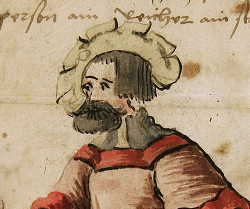 | |
| Born | 15th century |
| Died | 16th century |
| Occupation |
|
| Citizenship | Augsburg, Germany |
| Movement | Augsburg tradition |
| Influences | |
| Influenced | |
| Genres | Fencing manual |
| Language | Early New High German |
| Notable work(s) | Jörg Wilhalm Hutters kunst zu Augspurg |
| Archetype(s) |
|
| Manuscript(s) |
Cgm 3712 (1556)
|
| Concordance by | Michael Chidester |
| Signature | |
Jörg Wilhalm Hutter was a 16th century German fencing master. In addition to his fencing practice, his surname signifies that he was a hatter by trade, a fact that is confirmed in the tax records of Augsburg, Germany in 1501, 1504, and 1516.[citation needed] His writings clearly show that he stood in the tradition of the grand master Johannes Liechtenauer.
Hutter's treatise appears in four manuscripts written between 1522 and 1523. It covers the three core subjects of the core Liechtenauer tradition, unarmored longsword fencing and armored dueling on horse and on foot; while the longsword material consists largely of a slightly garbled rendering of Liechtenauer's verse, the armored material shows more originality. The oldest of Hutter's manuscripts, Codex I.6.4º.5, consists only of titled illustrations of armored fencing and mounted fencing; for this reason, Hils assumed it was the draftbook used to develop the others.[citation needed] This draftbook, along with the completed Codex I.6.2º.3, were created in 1522. In 1523, Hutter created an accompanying longsword treatise, preserved in the Codex I.6.2º.2. (This was also accompanied by Nicolaüs Augsburger's 1489 longsword treatise, without attribution.)
Some time after this, all of Hutter's works, as well as a brief series of new uncaptioned illustrations possibly drawn from the MS Cl. 23842, were compiled into the Cgm 3711. This manuscript has some oddities not found in the others, including carnival costumes on some of the fighters and a pretzel salesman appearing in the illustration on folio 11r. It's currently unclear whether Hutter was involved in the creation of this manuscript or not, but it might be a presentation copy prepared for a fan of his prior works.
Hutter's longsword treatise was copied by scultor Gregor Erhart into a manuscript in 1533, which was later acquired by Lienhart Sollinger and used as a source for his Cgm 3712. The Codex I.6.2º.2 was acquired by Paulus Hector Mair in 1544, the Codex I.6.4º.5 in 1552, the MS E.1939.65.354 in 1560, and the Codex I.6.2º.3 in 1561. The second was used as the primary source for his writings on armored and mounted fencing; due to its lack of text, he inserted his own descriptions of the devices—descriptions which diverge noticeably from Hutter's own explanations in the Codex I.6.2º.3.
Contents
Treatise
Images |
Complete Translation of Munich Version I (1523) |
Draftbook (1522) |
Archetype (1523) |
Munich Version I (1523) |
Glasgow Version (1533) |
Munich Version II (1556) |
Wolfenbüttel Version (1588) |
|---|---|---|---|---|---|---|---|
| [1r] Young knight learn, to have love for god and honor women. Speak to women well and be valiant, so that one shall hear you and also be available thereto. Do not let yourself be deceived by one’s tricks, go with courage to he who does injustice to you, and set your sense to a sincere principle, and to this end learn valiant chivalry, yet practice pinching and jesting with joy. Throw the stones, shoving staves, fencing and wrestling, dancing and jumping, stabbing and jousting, with that should one seem to curry favor with women, yet fencing wants to have pinching and jesting. The heart which easily frightens there, no fencing shall he learn, why whoever loses the art from the sword, he goes hazy, and also makes large sweeps, those softly warped hearts, therefore one hears very many stories, that the hopeless often will be hit, and is a righteous sense that a truth with fencing will be reached and art has not learned. Of that complaint, I myself Jörg Wilhalm Hutter from Augspurg open and ridicule . | [1r] Jungk Ritter lerne Gott lieb haben und frawen Erm Red frawen wol und bis manlich d[ ] (die) man dan sol hiert dich auch vor liegen darzu las dich nit betrÿegen trag aines manes mutt (ge)gen dem der dir unrecht thutt und setz dein sin in ein herliche sa[ ]z und lern darzu manliche Ritterschaft doch Scha...pffen und sch...zen mit freuden yeben Die stain stösse stangen schieben vechten und Ringen d[u]nzen und springen stechen und turnieren darmÿt sol man schene frawn hofieren doch schnipffen und scherizen vechten wil haben das herze walchr dar schricket gere kain vechten sol er nit Lernen warum wer verlorn die kunst vom schwertt gatt der dumst und auch die grose straich machent die verzug[e]e herzen waich darum hörtt man gar vil sagen Das die verzagtenv oft werdent gschlagen und ist ein doretter Sin das ein War (Mar) mitt vechten wil kumen hin und kunst nit glernet hatt des klag ich mich Jörg Wilhalm huttmachr von augspurg frie und spott | [2r] | |||||
[2r] Whoever wants to cut upon you, you shall parry it with joy. And whomever you have parried, thus send all of his cuts away.
If you want to behold the art, then to left and right with cuts and left with right is what you strongly desire to fence. Whoever goes after with cutting allow their art little joy. Cut nearing what you want, no change-through comes to your shield. To head, to body, don’t abandon the fencing, with the whole body fence, what you desire to drive strongly, hereafter what you strike crisply on. |
[2r] Wer auff dich wil hawen, versezen sol [es] dich frawen Und wen du hast versezt So send all sein haw gelezt
Wilstu kunst schawen so bis lingk und recht mit Hawen und lingkh mit rechten ist das du starken be Gerest zuvechten, wer nach geist mit hawen bedorff Sich kunst wenig frawen haw nachent was du wilt Kain durchwechsell kumpt an deinen schilt zu kopff zu leib das vechten mit vermied mit ganzem leib vich was du starckh begerest zutreiben hernach was du schlächst fris(t) auff |
[3v] | [97r] | ||||
| [2v] The two both stand on the left in the over cut.
Don’t fight above on the left if you are right handed, and otherwise if you are left handed and in the right also severely hindered. Before and after, the two things are the origin of all of the art. Weak and strong, understand this wait, with that note your work. Thus may you learn with art your work, and whoever frightens easily, he shall not learn to be a fencer. |
[2v] Die zwen stand baid glingks in dem oberhaw
Vicht nit oben glingks So du gerechts bist und ob du glingks bist und im rechten auch Ser hinckst vor und nach die Zway ding sind aller kunst [ ]in ursprung schwech und sterckh indes wart dein ar wait damit merckh so magstu lernen mit kunst erm arwairten und wer erstchricht gern der sol kain vechter lernen |
[4v] | [97v] | ||||
[3r] He stands in the over cut
This is from the wrath cut. Whoever cuts you from above, take the wrath cut strong on your shoulder and cut in straight, over the parry, and hang and wind with the sword as you want to thwart yourself, and allow to drop to both sides with half failers and hit him with the long edge to the right ear to the head away. |
[6r] Der statt im oberhaw
Das ist vom zornhaw wer dir oberhawet so nim den zornhaw starckh auff dein achseln vnd haw in schlecht hinein vber d[ie] versatzung vnd verheng vnd wind mit dem schwert als welte [?] dich zwerchen vnd lass obfallen zu baiden seÿtten mit hal[b] vellern vnd schlag in mit der langen schneid nach dem Rechten orr zu dem kopff hinweg |
[3r] Der stat im oberhaw
Das ist vom Zornhaw wer dir oberhawt so nim den Zornhaw starckh auff dein achseln und haw in schlecht hinein uber die versatsung und vorheng und wind mit dem schwert als welttestu dich Zwerchen und lass abfallen zu baiden seiten mit halben [voliern] und schlag in mit der langen schneid nach Dem Rechten Or zu dem Koppf [hinerg] |
[5v] | [98r] | |||
[3v] He stands in the over cut.
This is the wrath cut on the left side and, take the same from the left shoulder and cut him quickly in long to the head and hang and wind therewith, but let him run to you and hit yet again as written before, stand and face behind away. |
[6v] Der stett im oberhaw
[D]as ist der zornhaw auff der lingken |
[3v] Der stat im oberhaw
Das ist der Zornhaw auff der lingken Seitenn und den selben nim von der lingken achseln und haw im schnel hinein lang zu dem kopff und vorheng und wind damit und lass aber dir [velld] läuffen und schlag aber wie vor gschriben stat hnd hindersich hinweg |
[6v] | [98v] | |||
[4r] This is the wrath point
This is the justification and note: who cuts you from above, that you penetrate him with the wrath point and if he becomes aware, then take it away above without risk, and be strong here again, wind, cut and stab, if he sees it, then take it below. Note this precisely, cut, stab, weak and strong and take it with half failers, but hit in as before and facing behind away. |
[3r] Das ist der zorn ortt
Das ist die ausrichtung vnd merckh wer dir oberhawet das du im mitt dem zorn ortt eindringest vnd wirtt er des gewa[r] so nim es oben ab on gfar vnd bis starckh herwider wind haw vnd stich sicht ers so nim es nider das eben merkch haw stich schwech vnd sterckh vnd nims mit halben vellern vnd schlag aber hinein wie vor vnd hindersich hinweg |
[4r] Das ist der Zornortt
Das ist die ausrichtung und merckh wer dir oberhawt das du im mit dem Zornortt eindringest und wirtt er des gwar so ni es oben ab an gfar und bis starckh he[ ]wider wind haw und stich sicht ers so nim es und das eben merckh haw stich schwerth und starckh und win[ ] (wins, nims) mit halben vellern und schlag aber hinein wie vor und hindersich hinweg |
[7v] | [99r] | |||
[4v] He stands in the over cut.
This is the other wrath point on the other side, take it also thusly: If they indeed both wrath cut from the shoulder, and one must make a stab on a cut, and the cut must reject, and take that also quickly away like the above. |
[3v] Der stett im oberhaw
Das ist der ander zorn ortt auff der andern seÿtten den nim auch also wen sy gand baid wie der zornhaw von der achsel vn[d] mus ainer auss einem haw ain stich machen vnd mus den haw ver werffen vnd das nim auch flux hinweg wie das ober |
[4v] Der stat im oberhaw
Das ist der ander Zornortt auff der andern seitten den nim auch alss (also) wen sÿ gand baid wie der Zornhaw von der achsel und můs einer auf einem haw ain[ ]s[ ]ch machen und můss den haw verwerffen und das nim auch flu[ ] hinweg wÿe das obd |
[8v] | [99v] | |||
[5r] Here, fences to the war
This is the justification of the war: Whoever’s war aims above, he will be shamed from above below. understand this, before and after, don’t be quick to your war, understand this in all things if you want to make the war. Gloss note. [In Paulus Hector Mair’s hand] Year 1544 This book has formerly been Jörg Wilhalm Hutter’s, and in this year I have acquired it. p. h. mair |
[2r] Hie vacht an der krieg
Das ist die ausrichtung von dem krieg wer des kriegs oben remett der wirtt oben nider gschemet indes vor vnd nach dein krieg seÿ dir nit gach inn des in hallen sachen wiltu den krieg machen gloss merckh [In Paulus Hector Mair's hand]
|
[5r] Hie vacht an der krieg
Das ist die ausrichtung vom dem Krieg wer des Kriegs oben remet der wirt oben nider gschemmett indes vor und nach dem Krieg Seÿ dir wirt gach nim des in allen sachen wiltu den Krieg machen gloss merckh |
[9v] | [100r] | |||
| [5v] This play is in the war
This is also from the war, and should also know that in all windings, cleave and stab swords, run-over sword, wind out in all exchanges if you want to fool the masters. When they are very many, break over it , and also thereto realize how one bore with the war. Gloss note. |
[2v] Das stuckh ist inn dem krieg
Das ist auch von dem krieg vnd soltt auch wissen das in al[len] winden haw vnd stich schwerter vberlauffen schwert[t] auswinden in allem treffen wiltu den maistr~ äffen wan es sind gar vil brich daruber vnd auch darzu a[?] war wie ainer mit dem krieg gebar gloss merckh |
[5v] Das stuckh ist in dem krieg
Das ist auch von dem krieg und solt auch wissen das in allen winden haw und stich schwertter uberlauffen schwertt aus winden in allen traffen wiltu den maister [a]ffen wan es sind gar vil brich darubr und auch darzu nim war wir einer mit dem krieg gebar gloss merckh |
[10v] | [100v] | |||
| [6r] This is an outer winding and break from the war
This is another play from the war and a break of the previous play, and is an outer winding that goes: cut or stab, find slices well. Also you should cut, stab, slice under in all exchanges if you want to fool the master. |
[4r] Das ist ein auswinden vnd bruch von dem krieg
Das ist aber ain stuckh von dem krieg vnd ain |
[6r] Das ist ein auswinden und bruch von den krieg
Das ist aber ein stuckh von dem krieg und ein bruch des vordern stuckh und iste ein auswinden das gert haw / stich gurt schneiden finden auch soltu mit brauchen haw stich scheiend (schniend, scherend) under in allem treffen wilttu den maister äffen |
[11v] | [101r] | |||
| [6v] This is also from the war
This is also from the war: squint to the point and take the neck without contest . You should also utilize the crooked and stab around and on and test his techniques, whether he is soft or hard in his technique. Gloss note. |
[5r] Das ist auch von dem krieg
Das ist auch von dem krieg schulch zu dem ortt vnd nim den hals one forcht auch solttu verwenden krum vnd [?] vm vnd auff vnd brieff im seim gefertt ob er seÿ waich o[der] hörtt im sein gförtt gloss merckh |
[6v] Das ist auch von dem krieg
Das ist auch von dem krieg schulch zu dem ortt und nim den hals one forcht auch solttu verwenden krüm und sich umb und auff und brieff im sein gfertt ob er seÿ waich oder hertt in sein gfertt gloss merckh |
[13v] | [101v] | |||
| [7r] This is also from the war
This is the justification for the war: Who thusly fights one with the sword near the neck, he must turn with a winding through and wind again. That goes good weak and strong below and turn your sword at the neck and jerk the left foot behind you and slice in, otherwise the neck. Gloss note. |
[5v] Das ist auch von dem krieg
Das ist von dem krieg die ausrichtung wer also ainen vacht beÿ dem hals mit dem schwertt der muß nemen mit ein durch winden vnd wider winden das geit gutt schwech vnd sterckh vinden vnd verwend dein schwert an dem halss vnd zuckh denn lingkhen fuss hindersich vnd schneid in ob dem hals gloss merckh |
[7r] Das ist auch von dem krieg
Das ist von dem krieg die ausrichtung wer also ainen vacht beÿ dem halss mit dem schwertt der mus wenen mit ein durch winden und wůder winden das geit gutt schwech und sterckh unden und verwend dein schwertt an dem halss und zuckh den lingken fuss hindersich und schnied (schneid) in ob dem halss gloss merckh |
[14v] | [102r] | |||
| [7v] Those are points in the war
Those are the false points in the war. Go earnestly to whom, why it belongs to many passages as well, and wind below through or wind above over nimbly and throw the point onto the hands and turn forcefully. Run through also if you want to wrestle. |
[4v] Das sind örtter in dem krieg
Das sind die valschen örtter in dem krieg das gat ernstlich zu wen warum es gehörend vil durch geng darzu vnd winden vnden durch oder wind oben vber behend vnd wirff den ortt auff die hend vnd verker zwingen durchlauff auch willtu Ringen |
[7v] Das sind örtter in dem krieg
Das sind die valschen örtter in dein krieg das gatt ernstlichen zu wen warum es geherend vil durch geng darzu und winden unden durch oder wind oben uber behend und wieff den ortt auff die hend und verber Zwingen durchlauff auch wiltu Ringen |
[12v] | [102v] | |||
| [8r] This is also from the war
This is the war when you strike someone onto the right side, then the other takes the war and no longer needs you, then parry your opening with the long edge and thus he dreads you with the sword above over, and do as you see it pictured. |
[38r] Das ist auch von dem krieg
Das ist der krieg wan du einen schlechst in die Rechten Seitten so nimpt der ander den krieg vnd bedarff dir nit mer dan dein blöss versetzen mit der langen schneid vnd so scheust er dir mit dem schwertt oben vber vnd thu als du es gmaltt sichst |
[8r] Das ist auch von dem krieg
Das ist der krieg wan du einen schlechst in die Rechten seitn so nimpt der ander den krieg und bedorff dir nit mer gan dem blöss versetsen mit der langen schneid und se scheust er dir mit dem schwertt oben uber und chu als du es gmalt sichst |
[f 15v missing from manuscript] | [103r] | |||
| [8v] This is a sword taking, also from the war
Gloss note: This is a sword taking and goes from the war. One takes that very slightly away, then there are yet very many good plays that belong to the war, and of the war is many things, and therefore you should note very many things. |
[38v] Das ist auch von dem krieg ein schwertt nemen
Gloss merckh das ist ein schwertt nemen vnd get au[s] dem krieg das nimpt einer gar gering hinweg dan es sind noch gar vil guttr~ stuckh die zu dem krieg gehörentt vnd ist des kriegen mangerleÿ vnd darumb so solttu merckhen gar vil ding |
[8v] Das ist auch von dem krieg ein schwertnemen
Gloss merckh das ist ein schwertnemen und get auss dem krieg das nimpt einer gar gering hinweg das es sind noch gar vil gutter stuckh die zu dem krieg gehörentt und ist des kriegen mangerlaÿ und darum so solttu merckhen gar vil d[in]g |
[16v] | [103v] | |||
[9r] Here fencing to the four openings
Here fence to the openings to the head and also to the side. Know to aim for the four openings, thus you will hit wisely without fear, without all doubt how he bore, you will be aware of that. Also, it comes a gain at the end hereafter how you shall break the four openings. Gloss note. |
[39r] Hie vachen an die vier blöss
Hie vachtt an die bloss zum kopff vnd auch zu der Seitt die vier blöss wis zu Remen so schlechstu gwiss on all gefar on allen zwiuel wie er gebar das wirstu wir [?] gewar auch kumptt es nach hinden hernach wie du soltt die vier blöss brechen gloss merckh |
[9r] Hie vachen an die vier blöss
Hie vacht an die blöss zuin kopff und auch zu der seitten die vier blöss wiss zu Remen so schlechstu g[ ]ns on all gefar on allen zweiuel wie er ge bar das wirstu wol gewar auch kumpt es noch hinden hernach wie du soltt die vier blöss brechne gloss merckh |
[17v] | [104r] | |||
| [9v] Those are also two openings
Those are the other two openings to the other side, therefore deceive and note on as the whole, and whoever takes the openings below, they will be shamed above near the ears. Gloss note weak and strong. |
[39v] Das sind auch zwu blöss
Das sind die andern zwu blöss zu der andern seitten darumb so lug vnd merckh auff wie die gand vnd we[r] die blöß vnden nemett der wirtt oben bei den oren gschemett gloss merckh schwech vnd sterckh |
[9v] Das sind auch zwen blöss
Das sind die andern zwen bloss zu der andern seittn darum so ling (lung) und merckh auff wie die gand und wer die blöss unden nemet der wirtt [ ]en beÿ den arn gschemett gloss merckh schwech und sterchk |
[18v] | [104v] | |||
[10r] This is the crooked cut on the right side change.
This is the justification for the crooked cut: cut crooked on nimbly, throw the point on the hands, cut crooked to the flats if you want to weaken the masters. Don’t cut crooked, cut short, with it show your change through, or use if you want to wrestle, and step to him in the triangle. Gloss note. |
[40r] Das ist der krumphaw auff der Rechtñ seiten wechsel
Das ist von dem krumphaw die ausrichtung krumb auff behen[d] wirff den ortt auff die hend haw krump zu der vleche[n] wilttu den maistr~ äffen krumb nit kurtzhaw dein durch wechsel damit schaw oder verwend wilttu Ringen vnd dritt im in den driangel gloss merckh |
[10r] Das ist der krumphaw auff der Rechten Seÿten wechsell
Das ist von dem krumphaw die ausrichtung krum auff behend wirff den ortt auff die hend haw krum zu der flöche wiltu den maistr schwechn krum nit kurzhaw dein durchwechsel damitt Schaw oder verwend wilstu Ringen und drit im in den driangel gloss merckh |
[19v] | [105r] | |||
[10v] He stands in the over-cut
That is, cut crooked on nimbly. Whoever parries well with striding, he sets many cuts awry . Cut crooked to the flats if you want to weaken the master. When it sparks above, thus stand away, that I want to praise. Strike crooked and not short cut, with it show the change through. Cut crooked whoever errs you, the noble war confuses him. Inserted page, back [In a 19th Century hand] Pg. 41 was attached between 15 and 16 |
[40v] Der statt im oberhaw
Das ist krump auff behennd wer wol versetzt mit schreittñ er vil hew letzt haw krumb zu der flöchen wiltu den maister schwechen wan es glitzt oben so stand ab das wi[l] ich loben krump schlecht vnd nit kurtz haw den durchwech[sel] damit schaw haw krumb wer dich Irret der edel krieg I[n] verwirret Eingefügtes Blatt, verso
|
[10v] Der stat im oberhaw
Das ist krump auff behend wer vol versezt mit Sch[rie]ttn er vil haw lezt haw krum zu der vlech e[i]n wilstu den maistr schwechen wan es glizt oben so Stand ab das wil ich loben krum schlecht und nÿt kurzhaw den durchwechsel damit schaw haw krum wer dich Ieret der edel krieg in verwirett |
[20v] | [105v] | |||
[11r] This is how one should break the four openings. The first: He hits in with the opening in the side. Then break the second: Be to him and hit in behind on his head.
This is opening breaking, and you want to reckon yourself, artfully break the four openings, you double above, rightly mutate below. I say to you truthfully, no man protects himself without danger, if you have heard, he may come to hit nobody. That I have heard. Gloss note. |
[8r] Das ist wie man die vier blöss brechen sol der ein der schlecht in mit blöss in die seitten so bricht der ander sÿ Im vnd schlöcht in hinden auff sein kopff
Das ist blöss brechen vnd wiltu dich Rechen die vier blöss kuns[t]lichen brechen du oben Duplier vnden Recht muttier ich sag dir virwar sich bschutzet kain man anefar hastu vernomen zu schlagen mag er kainer kumen das hab ich vernomen gloss merckh |
[11r] Das ist wie man die vÿer blöss brechen sol der ein der schlecht in mit der blöss in die seitten So bricht der ander Sy Im und schlecht in hinden auff Sein kopff
Das ist blöss brechen und wilstu dich Rechen die vier blöss kunstlichen brechen du oben duplier unden Recht muttier ich sags die virwar sich b(e)schuhzt kain man one far hastu vernemen zu schla[g]en mag [ r] kainer kumen das ha[s] ich vernomen gloss merckh |
[21v] | [106r] | |||
[11v] There breaks this, the opening on the other side, and is also the opening breaking.
This is the opening breaking on the other side, and break as you see pictured. You must also double above, and mutate correctly below. Note: The opening breaking should stand pictured in front before the crooked cut. |
[8v] Da bricht diser die blöss auff der andern Seitten vnd ist auch die blöss brechen
Das ist die blöss brechen auff der andern seitten vnd brich sÿ wie du si gemalt sichst du must auch oben dupplieren vnd vnden Recht mutieren Item die blöss brechen söltt gmalt sten dauorn vor dem krumphaw |
[11v] Da bricht diser die blöss auff der andern seitten und ist auch die blöss brechen
Das ist die blöss brechen auff der andern seitten und brich sÿ wie du Si gmaltt sichst du must auch oben dupplieren und unden Recht muttie renn Item die blöss brechen soltt gmalt sten dar[uo]n vor dem krumphaw |
[22v] | [106v] | |||
[12r] The guard from the day.
Note: These are two guards, and this is the guard from the day. He has his sword facing upwards, and the other has his sword facing downwards beside the left foot. This is the fool and is also called the iron gate. Then it is four guards. Ox and plow, those are also two guards. Gloss note. |
[14r] Die hutt vom tag
Item das sind zwu hutten vnd ist das die hutt von tag |
[12r] Die hutt vom tag
Item das sind zwu huttn und ist das die hutt von tag der sein schwertt ubersich hebt und der Ander der sein schwertt undersich hebt bei dem lingken fus das ist der Alber und haist auch die Eisin portt dan es sind vier hutten ochs und pflug das sind auch Zwu hutten gloss merkh |
[79v] | [107r] | |||
[12v] Skull cut.
Note: That is from the crown, etc. and then he raises the sword facing upwards. He stands in the skull cut, and the other in a position, and when he hits away from the roof, thus the other takes the crown all right . Gloss note. |
[14v] Schaitelhaw
Item das ist von der kron etc vnd der der das schwertt vbersich hebtt der statt in dem schaitelhaw vnd der ander in ein legr~ vnd wan der schlöchtt von dach ab so nimpt der ander die kron also schon gloss merckh |
[12v] Schaitelhaw
Item das ist von der kron [ ] und der der das schwertt ubersich hebt der statt in dem schaitelhaw und der ander in ein leger und wan der schlecht von dach ab so nimpt der ander die kron also schon gloss merckh |
[80v] | [107v] | |||
[13r] This is the thwart cut.
This is the thwart, it takes away what comes from the day, then thwart with the strong, with it note your work. The thwart to plow, join hard to the ox, and who themselves well thwarts, with jumping threatens your head, and whoever directs the failer on from below two times aims as he wishes. Gloss note. |
[7r] Das ist der zwerchhaw
Das ist die zwerch benimpt was von tag herkomptt die zwerc[h] mit der sterckh dein arwait damit merckh die zwerch zu pflug zu dem ochsen gehertt fug vnd was sich wol zwercht mit springen deim haupt gefert vnd was velle[r] verurrn von vnden auff zwifach nach wunsch sÿ Reren gloss merckh |
[13r] Das ist der Zwerchhaw
Das ist die Zwerch benimpt was von tag herkompt die Zwerch mit der sterckh dein arwait damit merckh die Zwerch zu pflug zu dem ochsen gehert fug und [ ] fertt und was veler veruarn von enden auff [ ] zwiuach nach wunsth Sÿ Rere[ ]tt gloss merckh |
[23v] | [108r] | |||
| [7v] This is the thwart on the other side.
He stands in the over-cut. This is the thwart on the other side, take it also as on the other side: invert, force, run through, and also wrestle, and in the elbows in the scale and step to the left, and don’t be lazy. In both thwarts may you wrestle. Gloss note. |
[7v] Das ist die zwerch auff der andern seitten
Das ist die zwerch auff der andern seitten den nim auch wie auff der andern seÿtten verkerr zwing durchlauff vnd auch Ring vnd In dem elenbogen in der wag vnd tritt in den lingken vnd bis nit laß in baÿden zwerchen magstu Ringen gloss merckh |
[13v] [Missing from transcription] | [24v] | [108v] | |||
[14r] He breaks the thwart.
This is the play of how one should break the thwart. There break one thwart, the second with placing upon and with shooting under and with shooting over thereof. You may take the two hangings if you want, then they are two hangings, that the one very narrow. Gloss mark |
[9r] Der bricht die zwerch
Das ist das stuckh wie einer die zwerch brechen sol da bricht ein zwerch die andern mit aufsÿtzen vnd mit vnderschliesen vnd mit vberschliessen darauß magstu neme[?] die zwaÿ hengen ob du wiltt den es sind zway hengen die den man ser engen gloss merckh |
[14r] Der bricht die Zwerch
Das ist das stuckh wie einer die Zwerch brechen sol da bricht ein Zwerch die andern mit auff sizen und mit underschiessen und mitt uberschiessen darauss magstu nemen die zwaÿ hengen ob du wiltt dan es sind zwaÿ hengen die den [ma]n se[r]r Engen gloss merckh |
[25v] | [109r] | |||
[14v] He stands in the guard from day and raises as much as he likes.
This is also a play from the thwart: What himself thwarts well drives with jumping to the head from one side to the other, is also one that is better than that, therefore hear. Gloss note. |
[9v] Der stet in der hutt von tag vnd wertt sich als vil er mag
Das ist auch ein stuckh von der zwerch was sich wol zwercht mit springen dem haubt gefert auff ein seitñ zu der andern ist auch eins das ist besser den das also vernim gloss merckh |
[14v] Der stett in der hutt von tag und wertt sich als vil er mag
Das ist auch ein stuckh von der Zwerch was sich wol Zwercht mit springen dem (dein) haubt gefertt auff ein seitten zu der andern ist auch eins das ist besser den das also vernim gloss merckh |
[26v] | [109v] | |||
| [15r] He lies in the thwart and has taken it with a jump, and shoves him to the arm away from him.
This is also from the thwart: One takes that also with a jump, take that as you see it pictured, thereafter comes the break, therefore it itself is then not a play for you, therefore it has a break. Note: heard art is beautiful. |
[10r] Der leit in der zwerch vnd hatt die genomen mit ein sprung vnd stost im den arm hinweg von Im
Das ist auch von der zwerch das nimpt man auch mit ein sprung das nim also wie du es gmalt sichst darna[ch] kumpt der bruch darum sich dich fur dan es ist kain stuckh es hatt ein bruch darum merckh kunst vernim sÿ |
[15r] Der [l]ett in der Zwerch und hatt die genomen mit ein sprung und S[t]ost im den arm hinweg von Im [ ]
Das ist auch von der Zwerch das nimpt man auch mit ein sprung das nim also wie du es gmalt sichst darnach kumpt der bruch der [Z]um sich dich vir dan es ist kam (kain) stuckh es hatt ein bruch darum merckh kunst ver Nim Sÿ schon |
[27v] | [110r] | |||
[15v] He also stands in the thwart, and then wants to shove away.
This is the break there-again: You may well quickly take a slice, and away from there that he may not obtain you, then a play breaks the second, and note thereby what is good to you. |
[10v] Der statt auch in der zwerch vnd den wil hinweg stossen
Das ist der bruch darwider du magst wol flux ein schnidt nemen vnd hinweg das er dich nit er langen mag den ein stuckh bricht das ander vnd merckh dabeÿ was dir gutt Seÿ |
[15v] Der statt auch in der Zwerch und den wil hinweg stossen
Das ist der bruch darwider du magst wol fluchs ein sch[ut]t nemen und hinweg das er dich nit erlangen mag den ein stuckh bricht das ander und merckh da[ ] was dir gutt Seÿ |
[28v] | [110v] | |||
| [16r] That is also driven from the thwart with jumping to the head, how he bore with his turn without fear.
This is also a play: what he well thwarts driving with jumping to the head, and a slice, a stab and ignore and fence at the neck, therefore understand it as you see pictured above . Gloss note. |
[11r] Das ist auch von der zwerch mit springen dem haubt gefertt wie er gebar mit seiner kar on als gefar
Das ist auch ein stuckh was sich wol zwercht mit spr[i]ngen dem haubt gefertt vnd ein schnidt ein stich vnd vbergenn vnd bei dem hals vachen also verstand es wie du es vnden gmalt findst gloss merckh |
[16r] Das ist auch von der Zwerch mit Springen dem haubt gefertt wie er gebar mit seiner kar (lar) on als gefar
Das ist auch ein stuckh was sich wol Zwercht mit springen dem haupt gefertt und ein schnidt Ein stich und ubergen und beÿ dem hals vachen Also verstand es wie [d]u es oben gmalt sichst gloss merckh |
[29v] | [111r] | |||
| [16v] This is the thwart in above, also a play.
This is yet again from the thwart from the above, that you then understand it: That very many come from the thwart, if one seeks it, when it is good makes to all things weak and strong. Gloss note. |
[11v] Das ist die zwerch oben ein auch ein stuckh
Das ist aber von der zwerch von dem vbergen das du es verstandest das gar vil auß der zwerch kumptt wen man es sucht wan sÿ ist gutt zu allen sachen schwech vnd sterckh machen gloss merckh |
[16v] Das ist die Zwerch oben ein auch in stuckh
Das ist aber von der Zwerch von dem uber [D]en das du es verstandest das gar vil aus der Zwerch kumpt wen man es sucht wen Sÿ ist gutt zu allen sachen schwech und Sterckh machen gloss merckh |
[30v] | [111v] | |||
[17r] This is the ox.
This is the justification for the ox and the plow, the thing and the second thing are an origin of all art. Ox and pflug are justifiably hard in the war, in all things, with which to make the old slice. Thus you are sure in all things and it may not fail you. |
[12r] Das ist der ochss
Das ist von dem ochsen vnd pflug die ausrichtung die ding vnd die zwaÿ ding sind aller kunst ein vrsprunng ochs vnd pflug sind dem krieg hartten fug In allen sach[ñ] den altten schnidtt mit zemachen so bistu sichr~ in allen dingen vnd mag dir nit mislingen |
[17r] Das ist der ochss
Das ist von dem ochsen und pflug die ausricht ung die ding und die zwai ding sind aller kunst ein ursprung ochs und pflug sind dem krieg hattn fug In allen sachen den altt[n] schnidt mit zu machen so bistu sicher in allen dingen und mag dir nit [miselungenn] |
[31v] | [112r] | |||
[17v] This is the ox.
This is the other ox and plow and are also justifiably hard in the war. Note: The oxen and plow one should drive from both sides, then they have four windings and four points, that you may use as you wish, when they are also two guards. Gloss note. |
[12v] Das ist der ochs
Das ist der ander ochs vnd pflug vnd sind auch dem krieg hartten füg Item den ochsen vnd pflug sol man treibñ von baiden seitten dan sÿ haben vier winden vnd vier örtter die magstu brauchen wie du wiltt wen es sind auch zwu hutten gloss merckh |
[17v] Das ist der ochs
Das ist der ander ochs und pflug und sind auch dem krieg hatten fug Item den ochsen und pflug sol man treibn von baiden Seittn dan Sÿ haben vier winden und vor orttr die magstu brauchen wie du wiltt wan [es] Sind auch zwn huttn gloss merckh |
[32v] | [112v] | |||
| [18r] He stands armed [in half sword].
This is also from the squinter and has thus taken him in the neck. The other, an armed [half sword] play and breaks his play, as you see it pictured. This is also a play, a break. Gloss note. |
[18r] Der statt gewappet
Das ist auch von dem schilchr~ vnd hatt im den halss so nimpt der ander ein gewapnet stuckh vnd bricht in sein stuck[h] als du es gmalt sichst das ist auch ein stuckh ein bruch gloss merckh |
[18r] Der statt gewapent
Das ist auch von dem schilchr und hatt im den halss so nimpt der ander ain gewapnet stuckh und bricht Im sein stuckh als du es gmalt Sichst das ist auch ein stuckh ein bruch gloss merckh |
[37v] | [113r] | |||
| [18v] This is also from the squinter play and break, and there he has the sword on the neck. This is the break and the other the play. Note that as you see it pictured. | [18v] Das ist auch von dem schilchr~ stuckh vnd bruch vnd der do hatt das schwertt auff dem halss das ist der bruch vnd das ander das stuckh das merckh wie du es gmalt Sichst | [18v] Das ist auch von dem schilchr stuckh und bruch und der da hatt das schwertt auff dem halss das ist der bruch und das ander das stuckh das merckh wie du es gmalt Sichst | [38v] | [113v] | |||
| [19r] This is again from the squinter, the break, the run-over, that strongly breaks the squinter against him, hit or slice and away from there quickly and soon, and therefore is not a play, it is a break from it. Gloss note. | [19r] Das ist aber vom schilchr~ der bruch das vber lauffen das bricht im den schilchr~ starckh schlag oder schneid vnd hinweg flux vnd bald vnd darumb ist kain stuckh es ist ain bruch darauff gloss merckh | [19r] Das ist aber vom schilchr der bruch das uberlauffen das bricht im den schilchr starckh schlag oder schneid und hinweg fluchs und bald unnd darum ist [Ram] starckh es ist ain bruch darauff gloss merckh | [39v] | [114r] | |||
| [19v] Das ist ein ander stuckh von dem schilcher schilch zu dem ortt vnd nim den halss one forcht vnd dabey so merckh vnd lern kunst das du dich dar auß kundest Rechtñ gloss merckh | [19v] Das ist ain andr stuckh von dem schilchr Schilch zu dem ortt und nim den halss one forcht und da[ ]ben so merckh und lern kunst das du dich daraus [ ]undestu Rechtn gloss merckh | [40v] | [114v] | ||||
[16r] Der stett schlechts in der ober versatzung
Der schilcher ein bricht was buffel schlecht oder stichtt wer wechsel treibtt mit schilcher daraus beraubtt schilcht er dich kurtz an dein durchwechsel gesigt Im an schilch zu dem ortt vnd nim den halß one forcht schil[ch] zu dem obern hauptt k behend wilttu besterben vnd vnden schon |
[20r] Der statt schlechts in der ober versazung
Der schilchr einbricht was buffel schlöcht oder sticht wer wechselt treibtt mit schilchr dar aus beraubt schilcht er dich kurz an dein Durchwechsel gsigt im an schilch zu dem ortt und nim den hals one forcht schilcht zu dem obern haubtt behend wilttu best[r]eben und vinden schon |
[33v] | [115r] | ||||
[16v] Der statt schlechtz in der ober versatzung
Der schilcher dem antlitz ist geuar mit seiner kar der brust vast virwar was von Im kumptt die kron das abnimptt der schnidt durch die kron so brichstu sÿ hartt vnd schon die straich trucke mit schnidten sÿ obzucke In allen sachen lass vns frischlich machen |
[20v] Der statt schlechts in der ober versazung
Der schilchr dem antluz ist geuar mit seiner kar der brust vast v[uo]war was von im kumpt die kron das ab nimpt der schnidt durch die kron so brichstu Sÿ hartt und schon die straich druckh mit schnidtn Sÿ abzuckh in allen sachen lass un[s] frisch hÿch machen |
[34v] | [115v] | ||||
[17r] Das ist schilch zu dem ortt vnd nim den hals one forcht vnd darzu starck in der wag
Das ist vom schilchr~ schilch zu dem ortt vnd nim den hal[s] one forcht vnd stel dich in die wag vnd haltt fast an di[ch] vnd wen du von im wiltt so wind im aus vnd hinweg gloss merckh |
[21r] Das ist schilch zu dem ortt und nim den halss one forcht und darzu starckh in der wag
Das ist vom schilchr schilch zu dem ortt und nim den hals one forcht und stel dich in die wag und halt fast an dich und wen du von Im wiltt so wind im auss und hinweg gloss merckh |
[35v] | [116r] | ||||
[17v] Der schlecht oben vber
Das ist auch von dem schilchr~ vnd ist ein bruch darauff wie du es gmaltt sichst vnd nim war das noch mer stuckh sind die es brechen vnd nim eben war wie er gebar gloss merckh |
[21v] Der schlöcht oben uber
Das ist auch von dem schilchr und ist ein bruch darauff wie du es gmaltt sichst und nim war das noch mer stuckh sind die es brechen und nim Eben war wie er gebar gloss merckh |
[36v] | [116v] | ||||
[24r] Das ist der schaitelhaw
Das ist von dem schaitelhaw die ausrichtung das ist schilchr~ mit schaitler sÿ sind dem hawpt baid geferd der schaitler dem antlitz ist geuar mit seiner kar der brust vast gefar vnd was von im kompt die kron also schon gloss merckh |
[22r] Das ist der schaitelhaw
Das ist von dem schaittelhaw die ausrichtung das ist schilchr mit schaittler schaittler dem antliz ist geuar mit seiner kar der brust vast gefar und was von im kompt die kron also schon gloss merckh |
[41v] | [117r] | ||||
[24v] Das ist die kurtz schneid
Das ist auch vom schaitelhaw es ist zewissen das ainer den schaitelhaw sol nemen mit drew dritten vnd einer mag in nemen mit eim dritt den von im kumptt die kron das abnimpt der schnidt durch die kron so brichstu sÿ hartt schon die straich truck mit schnidten sÿ abzuckh gloss merckh |
[22v] Das ist die kurz schneid
Das ist auch vom schaitelhaw es ist zu wissen das ainer den schaitelhaw sol nemen mit drey (drew) dritten und einer mag in nemen mit ein drit der von im kumpt die kron das abnimpt der schnidt durch die kron so brichstu sÿ hartt und schon die straich druckh mit schnitten sÿ abzuckh gloss merckh |
[42v] | [117v] | ||||
[25r] Das ein versetzen
Das ist von den vier legern vnd auch alwegen ain leger vnd ein versetzen darauff die vier leger allain dauon haltt die sag vnd fleuch die gemain ochs vnd pflug alber vom tag ist wol sein fug |
[23r] Das ein versezen
Das ist von den vier legern und auch alwegen ain leger und ein versezen darauff die vier leger v allain dauon haltt die sag und fleuch die gemain ochs und pflug alber vom tag ist wol sein fug |
[43v] | [118r] | ||||
| [26r] Das ist auch von den lägern vnd ist zewissen das ein leger das ander bricht vnd das sind zwaÿ leger ainer leitt oben der ander vnden das merckh also vnd verni[m] das der vnderst dem obern wol durch mag gen vnd gieng im auff sein kopff vnd darumb durchgen thut[t] wol so ichs sagen sol gloss merckh | [23v] Das ist auch von den legern und ist zuwissen das ein leger das ander bricht und das sind zwai leger ainer leitt oben der ander unden das merckh also und ver nim das der underst dem obern wol durch mas gen und ging in auff sein kopff und darum durchgen thutt woll so ichs Sagen sol gloss merckh | [45v] | [118v] | ||||
| [26v] Das ist auch von den legern das der den auff dem leger scheust krumb auff vnd scheust im vber sein schwertt vnd ist das vberschiessen auch ein legr~ das ander brichtt gloss merckh | [24r] Das ist auch von den legern das der den auff dem leger schewst krum auff und scheust in uber sein hend schwertt und ist das uberschiessen auch ein leger das ander bricht gloss merckh | [46v] | [119r] | ||||
[25v] Das ist ein versetzen
Das ist von den vier versetzen die die leger ser letzen doch vor versetzen hiett dich geschicht es dir nott es miett dich vnd bis Resch vnd kom vor hastu vernomen zu kainer kunst mag er nit kumen gloss merckh |
[24v] Das ist ein versezen
Das ist von den vier versezen die die legr serr lezen doch vor versezen hut (hwt) dich gschicht es dir nott es miett dich und bis Resch und kum vor hastu ver nommen zu kainer kunst mag er nitt kumen gloss merckh. |
[44v] | [119v] | ||||
| [30r] Das ist aber von den vier legern vnd die versetzen darawff vnd vberschiessen das sind auch leger das merckh da vnden mit der sterckh vnd lang in der wag vnd wen er dich woltt auffheben so magstu ein schnidt nemen ob du wiltt oder mugs[t] verhengen was dir am basten fiegtt gloss merckh | [25r] Das ist aber von den vier legern und die versezen darauff und uberschiessen das sind auch leger das merckh da und e[ in ] mit der sterckh und laug in der Wag und wen er dich woltt ausheben so magstu ein schnidt nemen ob du wilt oder magst verhengen was dir am bestn vegtt gloss merckh | [47v] | |||||
| [30v] Das ist aber von den vier legern vnd von den versetzen da merck auff vnd schaw das sind auch zwaÿ leger vnd das ist auch ain leger der vberschossn hatt vnd haben die leger ein End vnd die vier versetzen sÿ sind all beieinander dan es ist Ir vil der Sÿ Suchtt gloss merckh | [25v] Das ist aber von den vier legern und von den versezen da merckh auff und shaw das Sind auch zwai leger und das ist auch ain leger der uberschossen hawt und haben die leger ein [E]nd und die vier versezen Sy sind als beÿ ein ander dan es ist es vil der sÿ suchtt gloss merckh | [48v] | |||||
| [31r] Das ist von dem nachRaisen lere zwiuach in der were vnd zwaÿ daraus nim vnd dein arwait daraus begind vnd brieff dein gfertt ob sÿ sind waich oder hert[t] das selb lere Indes das wortt schneidett Sere nach Raisen zwiuach so nimstu den altten schnidtt mitt macht vnd hab achtt gloss merckh | [26r] Das ist von dem nachRaisen lere zwiuach in der were und zwaÿ daraus nim und dein arwait darauss begind und brieff dein gfertt ab Sÿ sind waich oder hörtt das selb lere Indes das wortt schneidett Sere nachraisen zwiuach so nÿmstu den altten schnidt mit macht und hab acht? gloss merckh | [49v] | [120r] | ||||
| [31v] Das ist ein anders nachRaisen den das nachRaisen das Soltu nemen auff baiden seitten tritt lang wilttu schreitten wen das nachreisen ist mangerleÿ vnd das ist das nachRaisen wan einer dich gschlagen hatt vnd wil von dir gen oder abzwchen so volg im nach vnd vorr dich | [26v] Das ist ein anders nachraissen den das nachraisen das solttu wemen auff baiden Seitten dritt lang wilttu schreitten wen das nachraisen ist mangerlaÿ und das ist das nachraisen wan einer dich gschlagen hatt und wil von dir gen oder abziechen So volg im nach und wer dich gloss merckh | [50v] | [120v] | ||||
| [32r] Das ist von dem vberlauffen da merckh das das vberlauffen ist so einer den andern aussen vberlauft mit dem knopff auswendig mit macht vnd das ist ein ausser vber lauffen vnd der ist noch mer vnd darumb wan Einer dir wil vberlauffen so heb dein schwertt starckh in die höch So kan er dir nit vberlauffen glos[s] merckh | [27r] Das ist von dem uberlauffen da merckh das das uberlauffen ist so einer den andern aussen uberlauft mit dem knopff auswendig mit macht und das ist ein ausser uberlauffen und der ist noch mer und darum wan einer dir wil uberlauffen so heb dein schwertt Starckh in die höch so kan er dir nit uber lauffen gloss merckh | [51v] | [121r] | ||||
| [32v] Das ist auch von dem vber lauffen vnd das ist ein inwendigs vberlauffen vnd wer vnden Remett vnd wen dir ainer vberlauft so wirstu geschemett vnd wen es glutz oben so stand ab das wil ich loben dein arwait [illegible deletion] mach waich oder hertt vnd druckh das zwifach wie du wiltt gloss merckh | [27v] Das ist auch von dem uberlauffen und das ist ein Inwendigs uberlauffen und wer undn Remett und wen dir ainer uberlauft so w[i]rstu geschemett und wen es glutzt oben so sez es ab das wil ich loben dein arwait mach waich oder hertt und druckh das zwur[ ]ch wie du wiltt gloss merckh | [52v] | [121v] | ||||
| [33r] Das ist auch ein vberlauffen vnd ist gewappet vnd gett ein Ringen damit vnd darum so merckh eben auff wan er wil in werffen vber den gling[ñ] fuss vnnd göhertt zu dem vberlauffen vil wen man suchen wil gloss merckh als es vnden gmaltt statt | [28r] Das ist auch ein uberlauffen und ist gewapp enntt (unntt) und get ein Ringen damit und darum So merckh eben auff wan er wil in werffen uber den glincken fus und gehörtt zu dem uberlauffen vil wen man suchen will gloss merckh als es eben gmalt statt | [53v] | [122r] | ||||
| [33v] Das ist auch ein vberlauffen mit dem knopff vnd ein vberlauffen gewappett mit Ringenn wie vor vnd Ruckh in vnd wirff in damit vnd thu als es vnden gmaltt Stett gloss merck[h] also die vberlauffen | [28v] Das ist auch ein uberlauffen mit dem knopff und Ein uberlauffen gewappet mit Ringen wie vor und Ruckh In und wirff in damit und thu als es oben gmaltt statt gloss merckh also die uberlauffen | [54v] | [122v] | ||||
| [34r] Das ist von dem absetzen wer auff dich hawtt von dach ab So setz im ab mit dem schwertt mit der kurtze[n] schneid Sein haw ist er waich so las vmb dein kopf[f] gen vnd schlag in mit der zwerch ist er aber hertt so schlag nit vnd nim vnd verwind im an dein Schwertt vnd arwait gloss merckh als es vnd[ñ] gmaltt statt | [29r] Das ist von dem absezen wer auff dich hawt von dachab so sez im ab mitt dem schwertt mit der kurtzen schneid sein haw ist er waich so lass umb dein kopff gen und schlag in mit der Zwerch ist er aber hertt so schlag nit und nim und verwend im an dem schwertt und gloss merckh | [55v] | [123r] | ||||
| [34v] Ein absetzenn
Das ist ein absetzen auff der andern seitten vnd das nimpt man auch mit der kurtzen schneid wie vor vnd merckh auff die schwech vnd sterckh ober Seÿ waich oder hörtt gloss merckh |
[29v] Ein absetzenn
Das ist ein absezen auff der andern Seÿtten und das nimptt man auch mit der kurzen schneid wie vor und merckh auff die schwech und sterckh ob er Seÿ waich oder hertt gloss merckh |
[56v] | [123v] | ||||
[35r] Ein absetzetzeenn
Das ist von dem absetzen haw stich schneligklichen lötzen vnd der hinder ligt in dem langen ortt vnd der vorder setzt im ab mit eim absetzen |
[30r] Ein absezen
Das ist von dem absezen haw stich schnelig klichen lezen und der hinder ligt in dem langen ortt und der vorder sezt im ab mit ein absezen |
[57v] | [124r] | ||||
[35v] Ein absetzen
Das ist ein ander absetzen vnd der vorder setzt dem andern den ortt ab gloss merckh |
[30v] Eyn absetzen
Das ist ain annder absetzen unnd [du] oder stezt dem ander den ortt ab glosa merck |
[58v] | [124v] | ||||
[36r] Ein absetzen
Das ist wer wil absetzen hew stich schnelligkliche[n] letzenn vnd wer auff dich sticht so lug das dein ortt drift vnd dem Sein bricht von baiden seitte[n] drift wilttu schreitten das ist auch ein absetzen gloss merckh |
[31r] Ein absetzen
Das ist wer will absetzen hew stich schnelillichen letzen unnd wer auff stich wil so lug das dein ortt drift und den sein bricht von baiden seitten drift wilttu schreitn das ist auch wie ein ab Setzen gloss merckh |
[59v] | [125r] | ||||
[36v] Ein absetzen
Das ist wer wil absetzen haw stich krumb schneligk[l]ichen lötzen vnd ist auch Ein absetzen gloss merck[h] Als es vnden gmaltt statt |
[31v] Ein absezen
Das ist wer wil absezen haw stich kum (krum) schneligklichen lezen und ist auch Ein absezen gloss merckh [al]s es oben gmalt Statt |
[60v] | [125v] | ||||
| [37r] Das ist der erst oberschnidtt vber die arm vnd schneidtt ab die hörttung schnel vnd flux mit deim gfertt vnd hab acht vnd nim den schnidt mit macht vnd also thu glöss merckh als es vnd[ñ] gmalt statt | [32r] Das ist der erst oberschnidt uber die arm und schneid ab die hörttung schnel und flul mitt dein gfertt und hab acht und nim den schnidt mit macht und also zu thu gloss merckh als es unden oben gmaltt statt. | [61v] | [126r] | ||||
| [37v] Das ist der ander ober schnidt den nim auch mit der langen schneid gloss merckh | [32v] Das ist der ander oberschnidt den nim auch mit der langen schneid gloss merckh | [62v] | [126v] | ||||
| [27r] Das ist von dem vndern schnidt der dritt da schneid ab die hörttung durch baid arm das merckh als es vnden gmaltt statt vnd nim das schnel vnd bald hinweg gloss merckh | [33r] Das ist von dem undern schnidt der dritt da schneid ab dir hörttung durch baid arm das merckh als es oben gmaltt statt und nim das schnell und bald hinweg gloss merckh | [63v] | [127r] | ||||
| [27v] Das ist der viertt schnidt den nim auch wie du in vnden gmaltt sichst vnd nim in starckh oder waich wie du wiltt vnnd flux hinweg bald vnd bhend das dir dein schnidt volend gloß merckh | [33v] Das ist der viertt schnidt den nim auch wie du in unden gmaltt vinst und nim in Starckh oder waich wie du wiltt und flul hinweg bald und bhend das dir dein schnidt valendt gloss merckh | [64v] | [127v] | ||||
| [28r] Das ist auch ain oberschnidt den nim als du in vnden gmaltt sichst vnd schneid im ab die herttung schnel vnd flux vnd hinweg das er dich nit erfolg mit dem nach Reisen gloss merckh | [34r] Das ist auch ain oberschnidt den nim als du in oben gmaltt sichst und schneid im ab die herttund schnell und flul und hinweg das er dich nit erfolg mit dem nachreisen gloss merckh | [65v] | [128r] | ||||
| [28v] Item das ist der Altt schnidt den treibt der vorder den nim also vnd zeuch Im vnden auff durch den Rechten arm starckh vnd langk vbersich vnd flux hinweg gloss merckh | [34v] Item das ist der Altt schnidt den treibtt der vorder den nim also und z[ ]ch (zewch) im unden auff durch den Rechten o[r]en starckh und langk ubersich und fluchs hinweg gloss merckh | [66v] | [128v] | ||||
| [29r] Das ist der ander altt schnidtt zu der andern seitten den nim also wie er vnden gmalt statt vnd nim In flux auff vnd hindersich hinweg das er dich nit erlangk gloss | [35r] Das ist der altt ander altt schnidt zu der andern Seittn den nim also wie er oben gmaltt statt und nim in fl[ul] auff und hindersich hinweg das er dich nitt erlang gloss merckh | [67v] | [129r] | ||||
| [29v] Das ist von dem hend truckhen das schwertt truckh in die hend vnd thu das behend dein schwertt wend zu flöch durch die hende | [35v] Das ist von dem hend trugkhen das schwertt druckh in die hend und th[u] das bhend dein schwertt wend zu flech durch die hennd gloss merckh | [68v] | [129v] | ||||
| [20r] Das ist auch ein hendtrucken das nim also vnd merckh nim dein schwertt vnd schlag im nach der blöss vnd truckh in von dir starckh gloss merckh darauff vnd nim war wie er gebar | [36r] Das ist auch ein hend trucken das nim also und merckh nim dein schwertt und schlag Im nach der blöss und truckh Im vom dir starckh gloss merckh darauff und nim war wie er gebar | [69v] | [130r] | ||||
| [20v] Das ist von dem hengen etc zwaÿ hengen wend auß einer hand von der andern In allem gefertt haw Stich leger waich oder hörtt mit seim gefertt das ist das hengen das sich zwercht als du es vndñ gmaltt sichst gloss merckh das ist ein hengen au[ff] der einen Seitten das verstand Eben | [36v] Das ist von dem hengen [ ] zwaÿ hengen wend aus ainer hand von der andern In allem gfertt haw stich leger waich oder hertt mit sein gefertt das ist das hengen das sich zwerchtt als du es oben gmalt sichst gloss merckh das ist ain hengen auff der einen Seitten das werstand Eben | [70v] | [130v] | ||||
| [21r] Item das ist Ein anders hengen auff der andern seitten das thutt der mit dem kurtzen schwertt vnd heb den spitz bas vndersich wie du es vnden gmaltt sichst vnd Sind die zwaÿ hengen zwu gutt versatzung zu allen Sachen gloss merckh | [37r] Item das ist ain anders hengen auff der andern Seitten das thutt er mit dem kurzen schwertt und heb den spiz [d]as undersich wie du es oben gmaltt Sichst und sind die zwaÿ hengn zwu gutt versazung zu allen sachen gloss merckh | [71v] | [131r] | ||||
| [21v] Der brechfenster
Item das ist das sprechfenster brich vnd mach stand frölich vnd bsich Sein sach dein zwerch mit der sterck[h] vnd wind Im vnden durch vnd merckh als du es vnd gmaltt sichst gloss merckh |
[37v] Der brachfenster
Item das ist das sprechfenstr brich und mach stand frelich und bsich Sein sach dein zwerch mit der sterckh und wind Im unden durch und merckh als du es oben gmaltt Sichst gloss merckh |
[72v] | [131v] | ||||
| [22r] Ein langer ortt
Das ist von den vier valschen örttern vnd ist des einen ein langer ortt vnd Sÿ gend zu baiden seittñ dar merckh auff das im der lang ortt in das gsicht gatt vnd ist gutt zu allen sachen ein krieg damit zemachen gloss merckh als es vnden gemalt Statt |
[38r] Ein langer ortt
Das ist von den vier valschen orttern und ist das einen ein langer ortt und sÿ gend zu baiden seitten die merckh auff das im der lang ortt in das gsicht gatt und ist gutt zu allen sachen ein krieg damit zu machen gloss merckh als du es eben gmaltt vindst |
[73v] | [132r] | ||||
| [22v] Das ist der ander verborgen ortt den nim als du in oben gmalt sichst der gett auch zu dem gsichtt darumb so merckh auff vnd sich was gutt seÿ darauff | [38v] Das ist der ander verborgen ortt den nim als du in oben gmaltt sichst der gett auch zu dem gsicht darumb so merkh auff und such was gutt [S]eÿ darauff | [74v] | [132v] | ||||
| [23r] Das ist der tritt verborgen ortt vnd ist ein falscher ortt den merckh als er oben gmaltt statt du mags[t] auch nemen das durch gen oder durchwechsel wie du wilt das durch gen nim also gee im mit der spitzen vnden durch gloss merckh | [39r] Das ist der tritt verborgen ortt und ist ein valschen ortt den merckh als er oben gmaltt Statt du machst auch nemen das durchgen oder durchwechsel wie du wiltt das dur[ch] gen nim also gee im mit der spizen undn durch gloss merckh | [75v] | [133r] | ||||
| [23v] Das ist der viertt valsch ortt den nim auch also du in oben gmaltt Sichst vnd er tringt dem das schwert von der hand vnd ist auch ain gutter ortt vnd nim war vnd merckh darauff als du es gmaltt sichst | [39v] Das ist der viertt valsch ortt den nim auch also du in oben gmaltt schst und er dringt dem das schwertt von des hend und ist auch ain guttr ortt und nim war und merckh darauff Als du ab oben gmaltt sichst. | [76v] | [133v] | ||||
| [13r] Das ist aber ein falscher ortt vnd ein valscher dritt den nim als du in oben gmalt sichst vnd wan er auff dein schwertt veltt So wind auff mit dein schwertt so stastu in der langen versatzung gloss merckh | [40r] Das ist aber (ober) ein valschr ortt und ein valschr dritt den nim als du in oben gmalt sichst und wan er auff dein Schwertt veltt So wind auff mit dein schwertt so stastu in der langen versatzung glos merckh | [77v] | [134r] | ||||
| [13v] Der statt im einhorn
Das ist auch Ein valscher ortt vnd gett auß dem sprechfenster vnd denn nim als du es oben gmalt Sist vnd ist das einhorn gloss merckh |
[40v] Der statt im einhorn
Das ist auch ein valscher ortt und gett aus dem sprechfenster und den nim als du es oben gmalt sichst und ist das einhorn gloss merckh |
[78v] | [134v] | ||||
| [15r] Item das ist die kron der sein schwertt gewappent heltt in der hand schon vnd nim war schon mit der kron die ist gutt In alle weg zu allen weren vnd biss starckh dar In oder schwach wie du wiltt gloss merckh | [41r] Item das ist die kron der sein schwertt gewappent heltt in der hand schon und nim war schon mit der kron die ist gutt in alle was zu allen weren und bis starckh darin oder schwach wie du wiltt gloss merckh | [81v] | [135r] | ||||
| [15v] Das ist der schnidtt durch die kron vnd den nim also Schon Als du es gmalt sichst in allen Sachen wilttu ein schnit machen gloss merckh schon auff den schnidt in der kron | [41v] Das ist der schnid durch die kron und den nim also schon als du es gmalt sichst in allen sachen wilttu ein schnitt machen gloss merck schon auff den schnidt in der Kron | [82v] | [135v] | ||||
| [41r] Item das ist der bruch auff die kron da merckh also schon als du es gmaltt sichst vnd der das schwertt vber Sich hebt der bricht die kron mit dem Reissen am schwertt mit dem kreutz da lug auff wen er Reist im die kron hinweg gloss merckh
Hie hatt der lanng zettel ein end vnd das helff vnss gott also behend vnd ist die kron das Aller letst vnd ist das aller best etc [In large figures] |
[42r] Item das ist der bruch auff die kron da merckh also shon als du es gmalt sichst und der das schwertt [und]ersich hebtt der bricht die kron mitt dem Vessen am schwertt mit dem kreuz da lug auff wen er Reist im die kron hinweg gloss merckh
Hie hatt der lang Zettel ein End das helff uns go[t]t also behend und ist die kron das Aller [h]etst und ist das aller best |
[83v]
|
[136r] |
For further information, including transcription and translation notes, see the discussion page.

